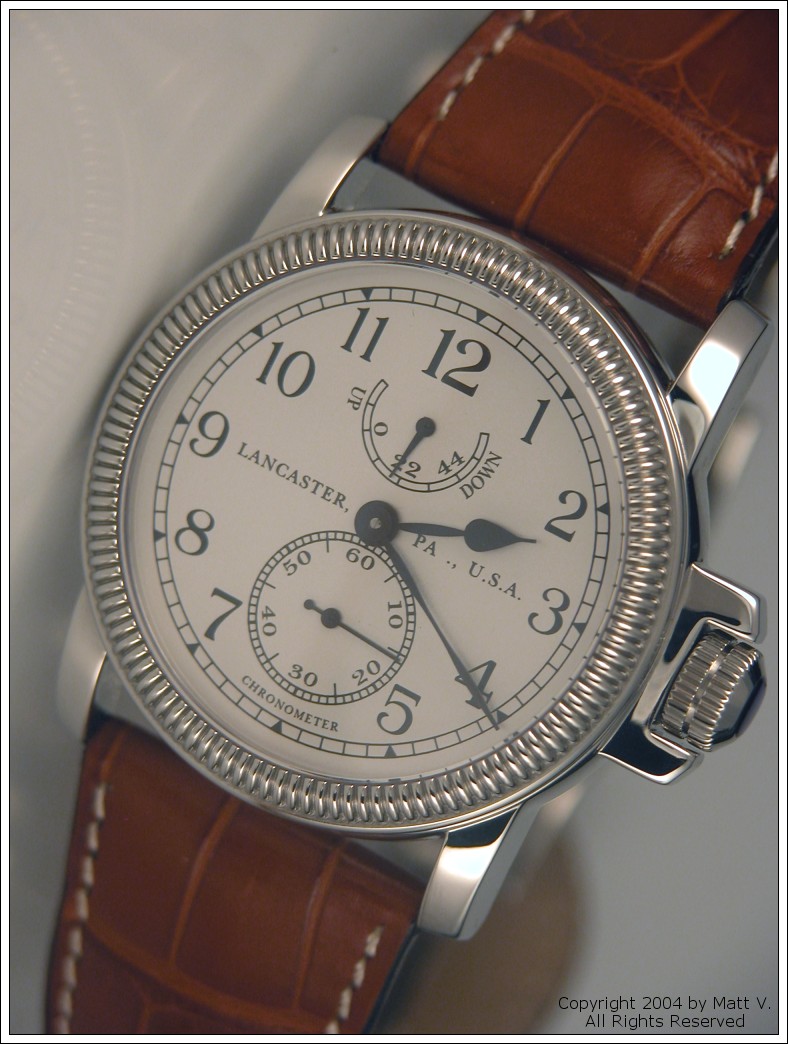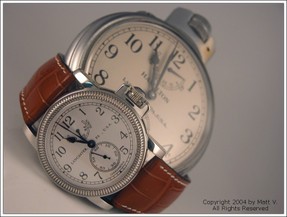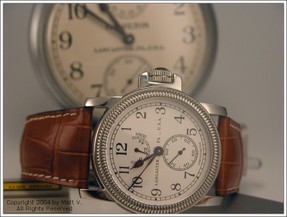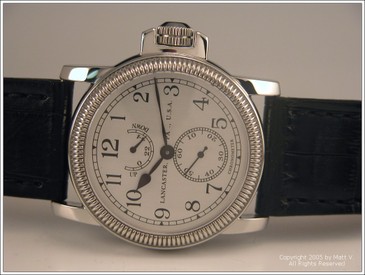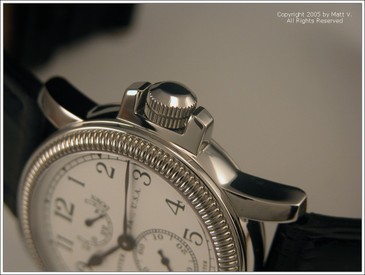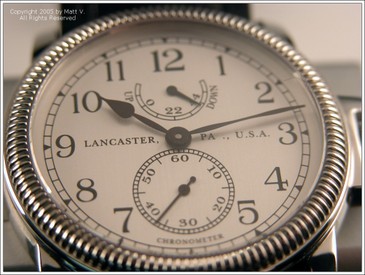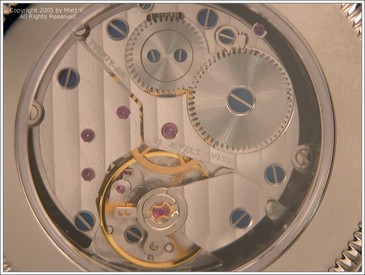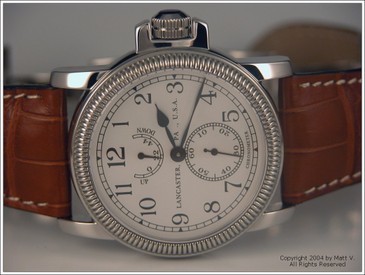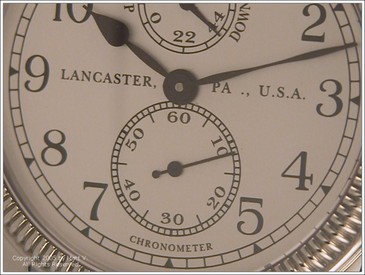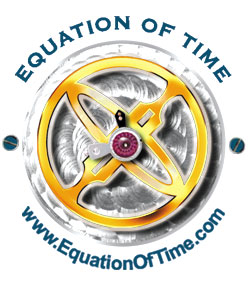 Equation of Time (RGM)
Equation of Time (RGM)
"22 Standard"
A Homage to Hamilton's classic deck watch
by Matt V.January 2005
The successful revival of a timeless classic...

Founded in Lancaster, Pennsylvania, in 1892, Hamilton has
been producing watches for the general public since 1893. But in 1940, the Hamilton
watch factory focused production on timepieces for the US military and supporting the war
efforts. Over one million different watches were produced in their factory during the
war and Hamilton continued to develop and produce new timepieces in Pennsylvania for as
long as 1969. Ever since, the Hamilton Watch Factory is part of the Swatch Group and
over the past few years has released a number of homage watches celebrating some of their
past horological successes. But let's go back to the 1940's and
World War II. When the US Navy Bureau of Ships was looking for an inexpensive deck
chronometer for use on Navy vessels, Hamilton responded. Ships at the time had to rely on
accurate timepieces not only for Navigation, but also to synchronize movements with other
ships for example in supply convoys, radio discipline and so on. 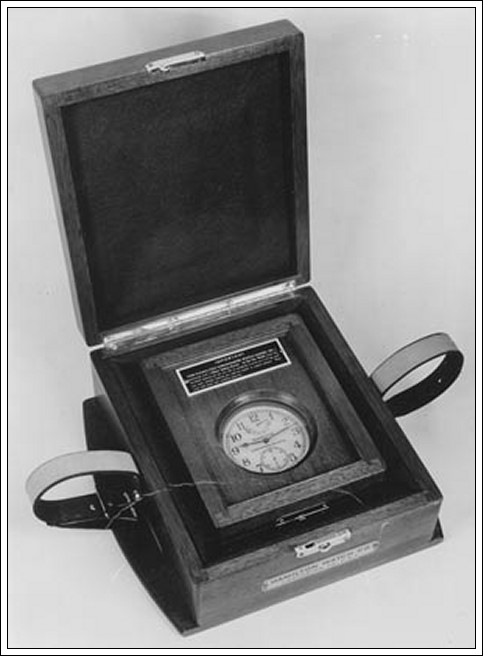 A mass produced (yet nevertheless
accurate) ships chronometer was an important detail to help keep ships moving and supply
lines going.
A mass produced (yet nevertheless
accurate) ships chronometer was an important detail to help keep ships moving and supply
lines going.
The challenge was nothing new: an English carpenter by the name of John Harrison was the first to build a successful clock that actually worked on a ship moving in all 3 dimensions. In the year 1761, John Harrison's famous "Chronometer #4" was successfully taken along during a sea voyage to use accurate time as a method of navigation (Longitude). Harrison proved that it was possible to create a timepiece that was both accurate enough to be used for navigation aboard a ship and small enough not to interfere with the ship's operation. Harrison’s clock however was extremely complex and difficult, thus expensive to reproduce. So in the 1780s and 1790s two great rivals, John Arnold and Thomas Earnshaw developed a new form of chronometer that could be mass-produced. Earnshaw invented a particular form of escapement with a device called a "spring detent" and a type of balance wheel that compensated for changes in temperature.
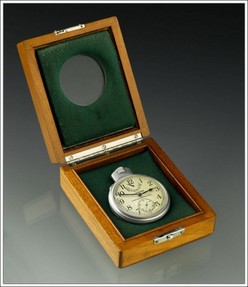 So how did Hamilton address the
issues at hand in the 1940's? How did they come up with ways to keep the watch wound
properly, avoid that an operator might setting the time by mistake when winding the watch,
keep the movement running accurately in different positions and at different
temperatures?
So how did Hamilton address the
issues at hand in the 1940's? How did they come up with ways to keep the watch wound
properly, avoid that an operator might setting the time by mistake when winding the watch,
keep the movement running accurately in different positions and at different
temperatures?
The new Hamilton deck chronometer was designed and built
specifically 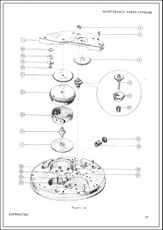 to
meet the
to
meet the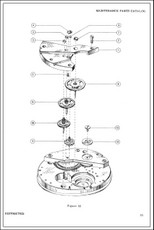 needs of the U.S. Navy. At a massive 35-size, it was by no means a small watch but
nevertheless it was smaller and constructed simpler than the famous model 21, making it
perfect for mass production. The movement inside the "Model 22" is a manual wind
21 jewel lever escapement chronometer movement with a Breguet style overcoil hairspring. A
60 inch long mainspring insured a steady amount of power to the gear train and a biaxial
thermal expansion balance wheel as well as an Elinvar hairspring are responsible to keep
the balance swinging at the same pace, independent of temperature. A power reserve
indicator as well as about 48 hours of power reserve helped keep the chronometer running.
needs of the U.S. Navy. At a massive 35-size, it was by no means a small watch but
nevertheless it was smaller and constructed simpler than the famous model 21, making it
perfect for mass production. The movement inside the "Model 22" is a manual wind
21 jewel lever escapement chronometer movement with a Breguet style overcoil hairspring. A
60 inch long mainspring insured a steady amount of power to the gear train and a biaxial
thermal expansion balance wheel as well as an Elinvar hairspring are responsible to keep
the balance swinging at the same pace, independent of temperature. A power reserve
indicator as well as about 48 hours of power reserve helped keep the chronometer running.
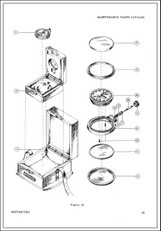 The whole package
was typically stored either inside a box with gimbals to keep the watch dial-up even
during extreme roll and pitch of a ship. However, another version looked more like a
pocket watch and was kept inside a padded box without any gimbals, but a glass covered
opening that allowed to see the time without opening the box.
The whole package
was typically stored either inside a box with gimbals to keep the watch dial-up even
during extreme roll and pitch of a ship. However, another version looked more like a
pocket watch and was kept inside a padded box without any gimbals, but a glass covered
opening that allowed to see the time without opening the box.
An ingenious "pin" on the outside of the watch case at
the 11 o'clock position needed to be depressed before the crown could be pulled out in
order to set the time; this simple "safety device" prevented accidental time
setting or change of time when winding the watch.
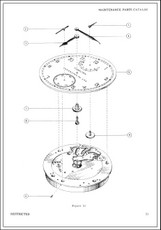 The dial of the "Model 22" was an off-white color (more of a
silver color in the civilian versions produced after the war) with black printing. No
luminous material was used on the dial or the large black "spade type" hands. A
unique and oversized crown with a groove in the middle placed in between thick crown
guards makes the Hamilton model 22 instantly recognizable while making it easy to wind the
watch or to set the time, probably even for the large fingers of a rough sailor
.
The dial of the "Model 22" was an off-white color (more of a
silver color in the civilian versions produced after the war) with black printing. No
luminous material was used on the dial or the large black "spade type" hands. A
unique and oversized crown with a groove in the middle placed in between thick crown
guards makes the Hamilton model 22 instantly recognizable while making it easy to wind the
watch or to set the time, probably even for the large fingers of a rough sailor
.
An acrylic (plastic) crystal in a coin edge bezel that is simply
screwed onto the watch case covers the dial, making it a breeze to replace the crystal
even without special tools should the need ever arise. The back is easily unscrewed as
well and a soft iron cover protects the movement from magnetic fields.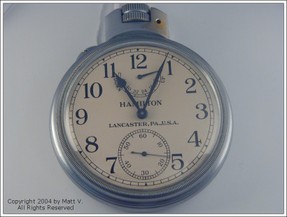
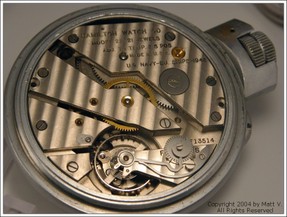
The movement itself is nicely decorated with Geneva stripes. Its designation is engraved and states "Hamilton Watch Co. Model 22, 21 jewels, Adjusted to Temp & 8 positions, Made in U.S.A." and in my case " US NAVY - BU Ships 1942" as well as the individual serial number. A fine regulation (that reminds me a little of a swan neck regulator somehow) helps adjust the regulator lever in small increments to regulate the movement to perform to chronometer specs even today.
The Hamilton "Model 22" is a classic Marine Chronometer and Deck Watch that certainly played a significant role in American horology, so it was only a matter of time before someone decided to pay homage to this watch and to come out with a wristwatch in the tradition of the Hamilton Model 22.
continue to Part II
Founded in Mount Joy (Lancaster County), Pennsylvania
around 1991, Roland Murphy's "RGM" watch company has long been an insider's tip
for great quality American watchmaking. Roland Murphy originally went  to
school for clock making in Lancaster, PA at the Bowman Technical school. In the
clockmaking course, he also covered pocket watches, which is how he discovered his
interest in watchmaking. Roland ended up going to school at WOSTEP in Switzerland in 1986
and returned to the US to work in the watch industry in product development for a
watch group and for one of their brands. He worked on the design of new watches, placing
orders for sample components like dials, hands and cases and discovered that he had a
talent for putting together new designs and watches. So in the early 1990's, that talent
turned into a business that today not only produces some of the finest custom timepieces,
but is also well known amongst watch enthusiasts for quality service work. Besides the RGM
line of watches, Roland started an endeavor to offer more affordable watches under the
"Equation of Time" label, also known for a watch and dive watch forum with the
same name on the Internet.
to
school for clock making in Lancaster, PA at the Bowman Technical school. In the
clockmaking course, he also covered pocket watches, which is how he discovered his
interest in watchmaking. Roland ended up going to school at WOSTEP in Switzerland in 1986
and returned to the US to work in the watch industry in product development for a
watch group and for one of their brands. He worked on the design of new watches, placing
orders for sample components like dials, hands and cases and discovered that he had a
talent for putting together new designs and watches. So in the early 1990's, that talent
turned into a business that today not only produces some of the finest custom timepieces,
but is also well known amongst watch enthusiasts for quality service work. Besides the RGM
line of watches, Roland started an endeavor to offer more affordable watches under the
"Equation of Time" label, also known for a watch and dive watch forum with the
same name on the Internet.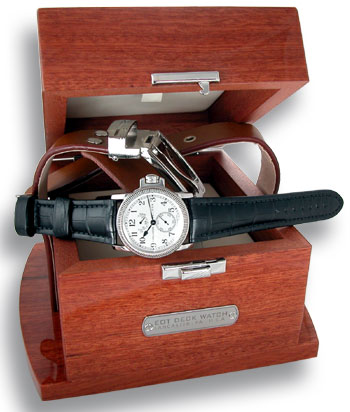
I don't recall when I first heard about the idea for the EOT model 22 on the watch forum. However I do remember seeing the first drawings and hearing about some of the ideas for the homage watch during a get-together of watch enthusiasts in Lancaster, PA at the "Convergence" event in 2003. At the time, a watch under at least 40mm in diameter didn't appeal to me at all and my requests to consider a larger case size went unheard. The following year, at the "Convergence" meeting in Lancaster in 2004, Roland officially introduced the model 22 and I finally had a chance to check it out "in the flesh" and to strap it on my wrist for a personal "test ride".
Well, I shouldn't have done that. This is the second time something like that has happened to me (the first time was trying on a Panerai "just for size" during a vacation in London in 2003 causing me to start saving my watch funds for a few months until I was finally able to buy my first Panerai) so what can I say: I fell in love with the watch right there and than.
Roland and Rich really tried everything to stay true to the
spirit of the Hamilton Model 22. From the look of the dial on their homage watch, the
hands, the crown and crown guards to the packaging with a rich wooden box with a thick
leather strap just like on the original deck watch box, part of the "Limited
Edition" package (see photo on the left, photo courtesy of EOT). 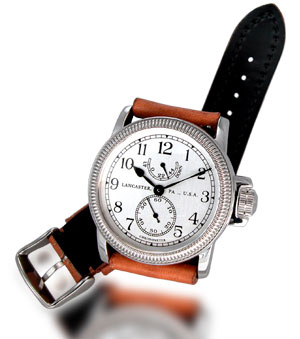
The "Limited Edition" sells at US$ 2,200.00 and offers the watch on an alligator strap with an inscribed case back and individual serial number (one of only 50 pieces). Furthermore it comes inside the wooden presentation box in the tradition of the Hamilton Model 22. The other version offered by EOT is the "Standard Edition". For US$ 1,800.00, it comes on a regular leather strap (with quick change spring bars), a steel case back without inscription / individual serial number and a pouch and outer box. An additional US$ 145.00 you can get a sapphire crystal case back and US$ 75.00 will buy you a different bezel (smooth) to change the looks of the watch.
Well, I went with the "Standard 22" plus the crystal case back and received it as a Christmas present from my wife this past Christmas. Since than, it has changed my views on non-black dial watches as well as watches that are less than 40mm in diameter and the EOT model 22 found its way onto my wrist surprisingly often even against some serious competition (see photo on the right, photo courtesy of EOT) .
The following is my review of the watch and features after a few weeks with the timepiece.
continue to Part III
Equation of Time (RGM) "22 Standard"
Watch Brand:
Equation Of Time
Watch Model: "22 Standard"
Serial No.: none
Date Purchased: 12/23/04
List Price: $1,800.00
Date of Review: 1/23/2005
|
|
|||||||||||||||||||||
WATCH REVIEW COMMENTS
I have only had the model 22 since last Christmas and am still in the "honeymoon phase" with this watch. The model 22 means more to me than just a unique new timepiece as it will forever remind me of two "Convergence" gatherings with fellow WIS in Lancaster, PA and the friendships that were struck during these weekends. Nevertheless, here are some of my impressions about the watch.
Movement
The EOT model 22 uses a 21-jewel, hand-wound "SO 7001RM" Swiss movement, finished with Geneva stripes and blued screws. According to the EOT site, it "includes some exclusive modifications". The movement is obviously based on a Peseux 7001 manual wind movement, produced since 1971 (now ETA). The original Peseux 7001 manual wind movement has a diameter of only 23.3 mm and a 2.5 mm height, only 17 Jewels, sub second at 6, a power reserve of 42 hours and beats at 21,600 bph. The version used here seems to be the modified version by "Soprod", the so called "cal. Peseux 7001-SO" with Nivarox 1 hairspring, Glucydur balance, adjusted to five positions and resulting in an increased height of 4mm to support a wind indicator (power reserve indicator) at the top, in line with the center of the sub-seconds at the bottom and the central minute and hour hands. I have no information about the extent and detail of the modifications for the EOT model 22 and the website doesn't offer more detail either about this unique movement. The only other watches I have seen so far using this movement are the Anonimo model 5002 (selling for $1,800 as well) and the Limes "GangReserve" (U73W.2-LHR1.1), selling for as low as $1425.00. The decoration is so nicely done that I absolutely recommend getting the crystal back option that allows a view of the mechanics!
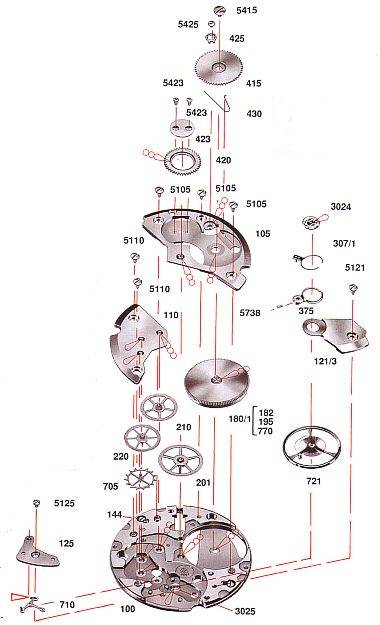

Case, Crystal and Crown
The stainless steel case of the model 22 is available in two different finished; polished or bead-blasted matte. My experience with other watches in the past has been that scratches were difficult to touch up or to remove with a bead-blasted finish, so I opted for the polished finish on my model 22. While it may be a little more flashy than the original Hamilton model 22 looks, this was going to be my dress watch and therefore the nicely polished finish was a plus for me. And indeed, the case and finish on my model 22 were absolutely smooth and perfect. Both the bezel as well as the sapphire case back have a beautiful coin edge which helps when you want to remove (unscrew) the bezel or case back. A really nice feature if you scratch or damage either and want to replace them. A slightly domed sapphire crystal has the original feel to it while offering modern scratch resistance. The crown looks like a miniature version of the original from Hamilton and is large enough to make winding or setting the watch a pure joy. Speaking about winding the movement: this thing winds really smooth and I remember someone saying about it that it's "just like butter".
The watch has a 39mm diameter without the crown and almost 45mm with crown. Lug tip to lug tip it measures 44mm and the lug width is 24mm.With the crystal back, it measures not quite 13mm thick.
Dial and Hands
Hamilton's original used black spade hands and the hands on the EOT model 22 look very similar to the original. One of the first things I noticed was that the minute hand of the EOT is a tiny bit longer than the minute track and extends over the edge. I am not sure if this is deliberate or a result of a missed tolerance and to be honest, I wasn't quite certain initially if this was going to bother me long term. However it seems that close-up photography exaggerates the issue and during regular use, I haven't even noticed it at all. The dial itself is an interesting silver gray color with a texture that sometimes looks bead-blasted, sometimes looks like it has been brushed in one direction. It seems to change color depending on the light, from a silver white to a warm off-white which contributes to its beauty. Under a loupe it almost looks like the dial printing is actually etched into the dial. No logo or manufacturers name adorns the face, just the "Lancaster, PA, U.S.A." and "Chronometer" designation as well as the "Up / Down" indications on the wind indicator. I did notice a small irregularity in the close-up shots of the number "20" in the sub seconds dial; not sure if this is an issue with just my watch or if the top of the number "2" is meant to be thinly printed on all dials. The hands are painted black with some sort of powder coating, which allows them to keep a classic matte black (anthracite), sometimes slightly brown appearing look rather than a modern shiny and more reflective "flashy" plastic look. A detail that I really appreciate on this watch!
Accuracy
The 21-jewel, hand-wound "SO 7001RM" came to me running 5 seconds fast per day on the wrist with a beat error of 0.3ms and a 326 degree amplitude. After about 4 weeks it is running now about +2s/24h on the wrist and still has the same beat error and amplitude. I am very happy with the performance so far, well within COSC chronometer specs and I can live with the fact that the movement doesn't "hack".
Strap, Buckle or Bracelet
In spite of its smaller size, the EOT model 22 has a 24mm lug width, just like the 44mm Panerai models and thus allows me to take advantage of all the 24mm straps that I have already collected for my Panerai (and all the interesting, often exotic 24mm straps that are being offered on the market in 24mm). The generic leather strap that came with the EOT "Standard 22" was nothing to rave about. While the "Special Edition" comes with a genuine alligator strap, this one simply comes with a padded leather strap (choice brown or black) with a quick-change springbar. The buckle is generic as well. While a nicer strap IMHO would have probably been fit for a watch at this price level, I understand the need to differentiate the "Limited Edition" from the "Standard Edition" and luckily have a few nice straps to wear the watch on. Currently I am switching back and forth between a padded alligator strap with large scales in tan color with white stitching (Breitling style, see below) and a thick alligator strap (Panerai style, see at the top) with large scales in black with matching black stitching.
User Manual and Packaging
The EOT model 22 came inside a black EOT leather pouch and outer box. No manual or additional warranty papers were included (but I believe that EOT/RGM has no problem tracking these watches to their respective owners for their 1 year warranty). The Packaging for the "Standard Version" is nothing fancy, but than again I didn't want to spend an additional US$ 400 for the "Limited Edition" with the nice wooden box, so I have nothing to complain about in regards to the basic packaging.
Comfort
Really not much to say about that one; the low and nicely down curving lugs set the watch low and comfortably on the wrist. All edges and corners are smooth, nothing that feels in the way. A note though: I am wearing my watches on the right wrist and have never been bothered by the large crown and crown guards, so I can't say with certainty if these could potentially be an issue and dig into the wrist/hand when the watch is worn on the left.
Value
The EOT model 22 is a very unique watch with a proud heritage, but even more importantly: it is a beautiful watch. I have caught myself so often over the past few weeks just admiring the simple beauty. I don't know what it is about this watch, its provenance, the fact that it was designed and assembled here in the US by a small independent watch manufacturer, the fact that only very few people know about them or own / wear them, the lack of "brand name" on the dial and watch...or simply its classic looks. I love this thing. By all standards, this is not an inexpensive watch and I have been asked by other WIS why I didn't go for a different watch instead, with examples ranging from various brand names to different styles of watches with totally different movements.
The answer isn't that simple. Yes, there are lots of watches at a lower price offering great value. But there is no other watch just like this, no other watch that I know off that feels like this to me and has the memories attached. I know and have met the people that made this watch, that designed it, that assembled it and that sent it out to me and I know that I can contact them should I need help with it. And as much as I'd have liked to get the cool wooden box and genuine alligator strap of the Limited Edition with the Standard Edition watch at the $1,800.00 price, I understand that Roland, Rich and the other guys from RGM have to make a living too. So if you can afford it, go for the LE; either way, this watch to me is a great value ESPECIALLY when comparing it to a lot of the mass produced/ mass marketed timekeepers out there. As always, your mileage may vary...
